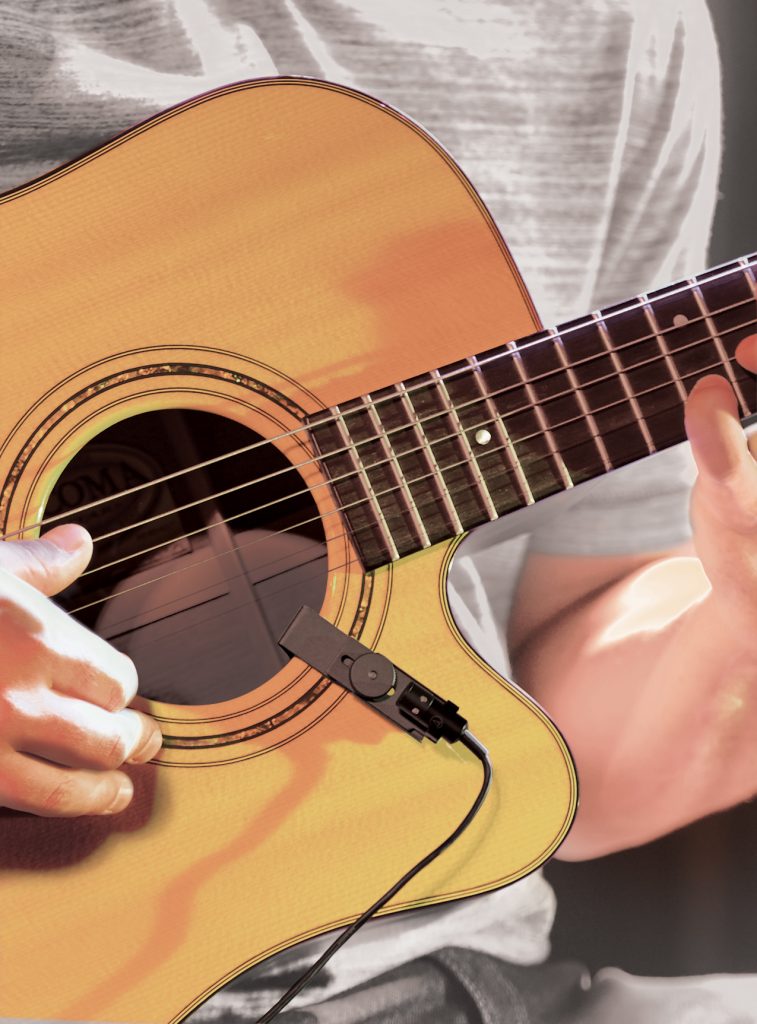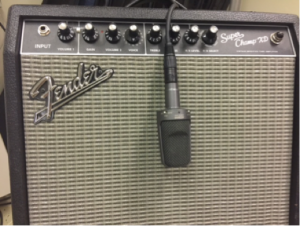Question: How do you mike musicians in a house of worship? (Part 6, Guitars)
Answer: For this installment of our miking musicians in a house of worship series, we will discuss a few options for miking acoustic guitars, and electric and bass guitar amps. The key to success in miking guitars in a house of worship is not only understanding the room size and number of musicians, but also selecting the proper microphone and placing it correctly around the instrument or amplifier. Below you will find some fantastic tips on mics to use for this application.
Acoustic Guitars: Nowadays it’s not uncommon for an acoustic guitarist to play an acoustic with a built-in preamp where they may plug directly into an amplifier, a direct box, or a mixing console with line inputs. What if the guitarist is playing an acoustic without a preamp? Time to return to the mic locker!
When we mic the acoustic we can do this in two ways: attach a microphone to the guitar in some way or place a microphone on a stand in front of the guitar. The best option of these two is to attach a microphone to the instrument. This way the microphone maintains its position in relation to the instrument. When a mic is placed on a stand, unfortunately you must rely on the musician to stay in that spot in front of the microphone, so you may find it very difficult to maintain consistent volume/tone.
Two mics that are often recommended for attaching to an acoustic guitar are the PRO 70 and the AT831b. These mics come with the AT8444 guitar adapter which snugly fits onto the sound hole of the guitar and points up at the strings. These mics also utilize the belt-pack style power module which attaches to the musician instead of being placed (to drag around) on the floor (yes you MUST use the power module).

Perhaps the guitarist is using a vintage acoustic they’d prefer not to attach a mic to. Or perhaps the guitarist is sitting down on a stool. In these cases, you could very well get away with using a mic on a stand and placing it in front of the guitar. When selecting mics to place on a stand you may want to go with a small diaphragm condenser such as our AT2021, PRO 37, or AE5100. You will want to have these aimed somewhere toward the sound hole and as close to it as possible to get the most volume from the guitar.
Electric Guitar Amps: Selecting microphones to use with guitar amps is a little different from selecting mics to use on an acoustic instrument because you won’t actually be miking the instrument, but rather a speaker. The mics you choose need to be able to handle the high SPL produced by the speaker, but you can either a dynamic or condenser mic. Two great dynamic mics to use with an electric guitar amp are the ATM650 and the AE2300. If you would like to give a condenser a try, the AE3000 also sounds fantastic on guitar amps.
Bass Guitar Amps: The concept of miking bass amps is similar to that of miking guitar amps – you want to select mics that can handle higher SPLs. For bass amps, however, you will also want a mic that can handle a higher impedance and adequately reproduce the low frequency response of a bass guitar. Two dynamic options that sound great on bass amps are the ATM250 and the BP40. But those are just our dynamic options, what about a condenser? What about using both at the same time? The AE2500 would be the best option! This dual-element cardioid instrument mic contains both a dynamic and a condenser element, allowing you to capture the aggressive attack of the driver while also capturing the sonic details of the bass.
After deciding which mics you are going to use for the amps, the next question is how will they be mounted? Of course you could use any standard mic stand that you may have available. You may also mount them onto a stand that can physically attach to the cabinet of the amp. As long as the mic is positioned so it is pointing at the cone of the speaker and placed as close to the grill of the amp as possible you can’t go wrong. To get the most desired tone out of the mic, you will need to do some experimenting and listen to various mic placements. However, you may find some helpful tips on mic placement techniques in the following videos:
If you decide to use the AE3000 with your electric guitar amp, a great trick we like to recommend for a fast-and-easy setup is to connect the mic to an XLR cable and loop the mic through the handle on top of the amp. Then you can simply hang the mic in front of the speaker of the amp. No need for an additional mic stand!

Once you have all of your guitarists and bassists miked up and ready to go, it’s time to move on to the next step. Next week we will discuss how to properly use in-ear monitoring systems in a house of worship, so stay tuned! As always, if you have any questions about the best miking solutions to use in your house of worship feel free to contact us here in the Audio Solutions Department.